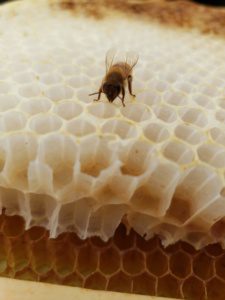It’s springtime at Fulfill— the weather is warmer, the days become longer, and our honey bees are buzzing! After a long, chilly winter, our honey bees are ready to spread their wings and enjoy spring. These small, yet mighty creatures lead very interesting lives, and it seems like a honey bee’s job is never complete.
 Early spring may be the most essential time period for honey bee survival, because of internal and external temperatures and food stores. Due to the fluctuating spring climate, honey bees must be cautious to not get caught away from the colony on a chilly night. Honey bees rarely leave the colony when the outside temperature is below 55F. If they decide to go foraging for food (nectar and pollen) If a colony lasts through the frigid days of winter, when spring arrives they will be in search of food for the newcomers and their queen bee. At this point, the queen bee’s laying rate will dramatically increase to around 1800 eggs daily, making her reliant on her worker bees to find food. A colony with a large population of worker honeybees stands a better chance of survival due to the added warmth and steady surge of fresh food they bring into the hive. In New Jersey, spring is the season in which, pollen and nectar are most abundant.
Early spring may be the most essential time period for honey bee survival, because of internal and external temperatures and food stores. Due to the fluctuating spring climate, honey bees must be cautious to not get caught away from the colony on a chilly night. Honey bees rarely leave the colony when the outside temperature is below 55F. If they decide to go foraging for food (nectar and pollen) If a colony lasts through the frigid days of winter, when spring arrives they will be in search of food for the newcomers and their queen bee. At this point, the queen bee’s laying rate will dramatically increase to around 1800 eggs daily, making her reliant on her worker bees to find food. A colony with a large population of worker honeybees stands a better chance of survival due to the added warmth and steady surge of fresh food they bring into the hive. In New Jersey, spring is the season in which, pollen and nectar are most abundant.
As a beekeeper, it is crucial to keep a watchful eye on daily temperatures and the number of food stores honey bees have left. A beekeeper will start to get an idea of which colonies are strong enough to swarm or split. One colony becomes two separate colonies during this process. Swarming is natural, while splitting is a commercial process, where the beekeeper uses the same measures of assessment that would occur naturally in a hive.
In nature, swarming occurs when the population in a colony gets so crowded that the resident queen leaves with 60% of her workers to a new location that is chosen prior to their mass exodus. Before she leaves, she lays a future queen in the original hive so they can start fresh.
 Commercially, splitting occurs when a beekeeper intervenes should they notice a colony being overpopulated. Splitting methods are dependent on the beekeeper themselves, as there are a few different methods. Traditionally, the beekeeper will remove four to six frames from the original hive to a new, pre-established home. The removed frames are full of brood (unborn honey bees), honey, nectar, pollen, a large portion of nurse honey bees, and the laying queen. This ensures a smooth transition for the remaining honey bees left in the hive. The nurse bees will quickly realize that their original queen is gone and will cater to their new queen. Once the new queen hatches from her cell she will take off on a nuptial flight, in search of 10-12 male drone bees to mate with. Upon her return, she’ll begin laying and will never leave the hive again.
Commercially, splitting occurs when a beekeeper intervenes should they notice a colony being overpopulated. Splitting methods are dependent on the beekeeper themselves, as there are a few different methods. Traditionally, the beekeeper will remove four to six frames from the original hive to a new, pre-established home. The removed frames are full of brood (unborn honey bees), honey, nectar, pollen, a large portion of nurse honey bees, and the laying queen. This ensures a smooth transition for the remaining honey bees left in the hive. The nurse bees will quickly realize that their original queen is gone and will cater to their new queen. Once the new queen hatches from her cell she will take off on a nuptial flight, in search of 10-12 male drone bees to mate with. Upon her return, she’ll begin laying and will never leave the hive again.
Every honeybee plays a unique role in the success of their hive, and it’s essential to ensure their health and safety so they can continue to get their special jobs done. Our Garden Coordinator is committed to his role as a beekeeper and works hard to maintain the colonies and harvest honey to distribute to our community. Fulfill is lucky to have our onsite bee colonies not only to pollinate our organic garden but also contribute to the growth of the overall population of honeybees.
